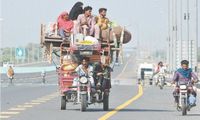On September 20, 2025, the Punjab government unveiled a sweeping strategy to address the devastation left by recent floods, announcing the formation of flood relief committees at both district and tehsil levels. The move, spearheaded by Chief Minister Maryam Nawaz, is designed to bring greater transparency and efficiency to aid distribution and rehabilitation efforts across the hardest-hit regions of Punjab, according to Dawn.
At a high-level meeting held on Friday, Chief Minister Nawaz introduced a suite of digital tools—a survey form, a mobile application, and a central monitoring dashboard—that she said would ensure effective oversight and equitable distribution of relief. "A survey form, a mobile application and a central monitoring dashboard will ensure effective aid distribution and oversight," Maryam Nawaz stated, as reported by Dawn. She instructed officials to launch comprehensive rehabilitation initiatives, prioritize the swift restoration of critical infrastructure like roads and bridges, and develop straightforward procedures to get assistance to those most in need.
The scale of the disaster is staggering. The floods have impacted 3,775 villages across 64 tehsils in 27 districts, leaving a trail of destruction in their wake. Over 63,000 concrete houses and more than 309,000 mud houses have been damaged, rendering thousands homeless and vulnerable. To ensure that aid reaches every affected family, survey teams made up of officials from the Urban Unit, Revenue Department, Agriculture Department, and the Pakistan Army have been dispatched to collect data and provide accurate assessments of the losses.
Chief Minister Nawaz was adamant that no flood victim should be left behind. "We will compensate each individual for their losses so that no one is deprived of their rightful relief," she declared, directing the establishment of additional relief camps and distribution points to meet the surging needs of the displaced.
The crisis deepened further when a breach of the Sutlej River at Noraja Bhutta submerged 150 more villages across Multan, Lodhran, and Bahawalpur districts. Thousands of residents were forced to flee as floodwaters swept over a 20-kilometre stretch near the Multan-Sukkur M-5 Motorway, a vital transportation artery. In Bahawalpur, villages such as Nowshera Jadeed, Saadullahpur, Soiwala, Nai Basti, and Basti Chakar found themselves underwater. The story was similar in Lodhran, where Adam Wahan, Munshi Wala, Jhangra, and Thali Wala were washed away.
One of the most severely affected areas is Jalalpur Pirwala, which remains submerged. Authorities are now weighing a drastic plan: breaching the motorway itself to redirect floodwaters into the Chenab River—a technical committee is expected to deliberate on this controversial proposal soon.
Multan Division Commissioner Amir Karim Khan took charge of rescue and relief operations in Jalalpur Pirwala, personally inspecting the damaged motorway section. National Highway Authority officials briefed him on ongoing repair work, which included the deployment of heavy machinery to fill in a breached section of a bridge. Meanwhile, the M-5 motorway remains closed to traffic, with alternate routes set up through the national highway at Shah Shams and Uch Sharif interchanges. "The M-5 was closed due to flooding, with diversions set up for travellers," confirmed motorway police spokesperson Imran Shah.
The human toll of the disaster is sobering. Punjab Disaster Management Authority (PDMA) Director General Irfan Ali Kathia reported that the death count in Punjab had reached 123. "A breached section of the bridge has been filled in," Kathia noted, adding that floodwaters have receded in several areas, allowing boat operations to be discontinued. According to Kathia, the monsoon season has officially ended and all rivers in Punjab have returned to normal levels, except for a slightly elevated flow in the Sutlej.
Statistics from the South Punjab Secretariat further highlight the catastrophe: 45 deaths, 1.17 million people affected, and 1,112 villages inundated. The floods have also wrought havoc on agriculture, damaging 1.17 million acres of farmland and destroying crops on 1.25 million acres. Relief efforts have been substantial, with 1,145 camps providing food, medicine, and other essentials. Over 1.5 million people and 1.47 million livestock have been evacuated, and medical treatment has been provided to 451,978 people and 848,119 animals.
As the government mobilized its resources, the political dimension of the relief effort came into sharper focus. Earlier this week, Pakistan People’s Party (PPP) Acting President Yusuf Raza Gilani visited Jalalpur Pirwala to assess the situation firsthand. Addressing the media, Gilani relayed PPP Chairman Bilawal Bhutto-Zardari’s call for the Benazir Income Support Programme (BISP) to play a central role in assisting flood victims. "The flood victims’ families should be supported via the BISP," Gilani insisted, after meeting with Adviser to the Prime Minister Rana Sanaullah to discuss both political matters and flood relief strategies.
However, not all in government agree on the best way forward. According to Gilani, while Bhutto-Zardari has emphasized the importance of BISP in delivering aid, Rana Sanaullah has advocated for assistance to be channeled through other government programs. This difference of opinion points to a broader debate within Pakistan’s political leadership about the most effective and transparent mechanisms for distributing relief—and how to avoid the pitfalls of bureaucracy or politicization that have sometimes hampered past efforts.
For the thousands of families displaced by the floods, these debates may seem far removed from the daily struggle for food, shelter, and safety. Yet the outcome will have real consequences for how quickly and effectively help arrives. As the waters begin to recede and the long process of rebuilding gets underway, the Punjab government’s new digital monitoring tools and the establishment of local relief committees offer hope for a more coordinated response. Still, the sheer scale of destruction—across homes, infrastructure, and farmland—means the road to recovery will be long and arduous.
In the days ahead, attention will remain fixed on whether the government can deliver on its promises of compensation, rehabilitation, and transparency. The coming weeks are likely to test both the resilience of Punjab’s communities and the capacity of its institutions to respond to one of the region’s most severe natural disasters in years.
With floodwaters finally receding and the monsoon season drawing to a close, the immediate danger may be passing—but the challenge of rebuilding shattered lives and livelihoods has only just begun.




